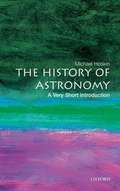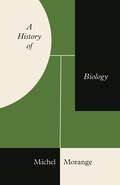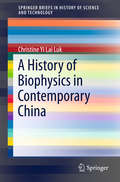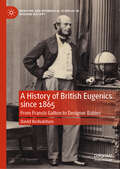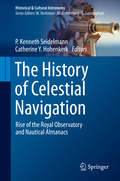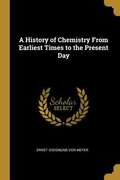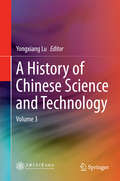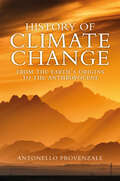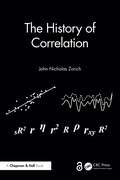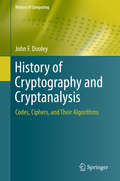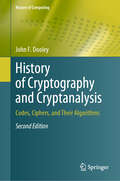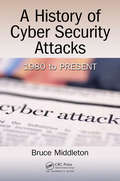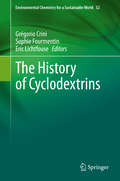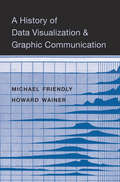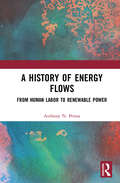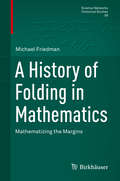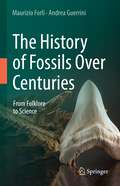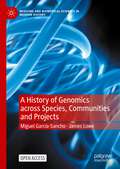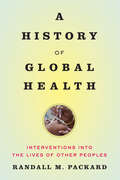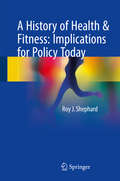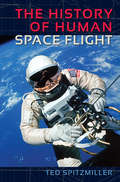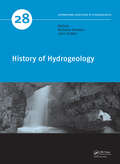- Table View
- List View
The History of Astronomy: A Very Short Introduction
by Michael HoskinThis is a fascinating introduction to the history of Western astronomy, from prehistoric times to the origins of astrophysics in the mid-nineteenth century. Historical records are first found in Babylon and Egypt, and after two millennia the arithmetical astronomy of the Babylonians merged with the Greek geometrical approach to culminate in the Almagest of Ptolemy. This legacy was transmitted to the Latin West via Islam, and led to Copernicus's claim that the Earth is in motion. In justifying this Kepler converted astronomy into a branch of dynamics, leading to Newton's universal law of gravity. The book concludes with eighteenth- and nineteenth-century applications of Newton's law, and the first explorations of the universe of stars.
A History of Balance, 1250-1375
by Joel KayeThe ideal of balance and its association with what is ordered, just, and healthful remained unchanged throughout the medieval period. The central place allotted to balance in the workings of nature and society also remained unchanged. What changed within the culture of scholasticism, between approximately 1280 and 1360, was the emergence of a greatly expanded sense of what balance is and can be. In this groundbreaking history of balance, Joel Kaye reveals that this new sense of balance and its potentialities became the basis of a new model of equilibrium, shaped and shared by the most acute and innovative thinkers of the period. Through a focus on four disciplines - scholastic economic thought, political thought, medical thought, and natural philosophy - Kaye's book reveals that this new model of equilibrium opened up striking new vistas of imaginative and speculative possibility, making possible a profound re-thinking of the world and its workings.
A History of Biology: A History Of The Molecular Revolution
by Michel MorangeA comprehensive history of the biological sciences from antiquity to the modern eraThis book presents a global history of the biological sciences from ancient times to today, providing needed perspective on the development of biological thought while shedding light on the field's upheavals and key breakthroughs through the ages. Michel Morange brings to life the dynamic interplay of science, society, and biology’s many subdisciplines, enabling readers to better appreciate the interdisciplinary exchanges that have shaped the field over the centuries.Each chapter of this incisive book focuses on a specific period in the history of biology, describing the major transformations that occurred, the enduring scientific concerns behind these changes, and the implications of yesterday's science for today's. Morange covers everything from the first cell theory to the origins of the concept of ecosystems, and offers perspectives on areas that are often neglected by historians of biology, such as ecology, ethology, and plant biology. Along the way, he highlights the contributions of technology, the important role of hypothesis and experimentation, and the cultural contexts in which some of the most breathtaking discoveries in biology were made.Unrivaled in scope and written by a world-renowned historian of science, A History of Biology is an ideal introduction for students and experts alike, and essential reading for anyone seeking to understand the present state of biological knowledge.
A History of Biophysics in Contemporary China (SpringerBriefs in History of Science and Technology)
by Christine Yi Lai LukThis book gives a concise history of biophysics in contemporary China, from about 1949 to 1976. It outlines how a science specialty evolved from an ambiguous and amorphous field into a fully-fledged academic discipline in the socio-institutional contexts of contemporary China. The book relates how, while initially consisting of cell biologists, the Chinese biophysics community redirected their disciplinary priorities toward rocket science in the late 1950s to accommodate the national interests of the time. Biophysicists who had worked on biological sounding rockets were drawn to the military sector and continued to contribute to human spaceflight in post-Mao China. Besides the rocket-and-space missions which provided the material context for biophysics to expand in the late 1950s and early 1960s, Chinese biophysicists also created research and educational programs surrounding biophysics by exploiting the institutional opportunities afforded by the policy emphasis on science's role to drive modernization. The book explores and demonstrates the collective achievements and struggles of Chinese biophysicists in building their scientific discipline.
A History of British Eugenics since 1865: From Francis Galton to Designer Babies (Medicine and Biomedical Sciences in Modern History)
by David RedvaldsenThis book examines British eugenics from its origins in 1865 to the early 1990s. It considers the two institutions promoting the doctrine: the Galton Laboratory attached to the University of London; and the Eugenics Society. It charts internal and ideological changes across more than a century, seeing eugenics as primarily a political movement. The doctrine had influence on British society and guided adherents ranging from scientists to charitable ladies. The Galton Laboratory published detailed studies of heredity. It transformed itself into a centre for medical genetics after the Second World War. As early as the 1920s, the Eugenics Society was the mainspring of the doctrine, formulating what became the British version of an international ideology. It began as applied social Darwinism, later incorporating a greater degree of meritocracy and amelioration. Its support for sterilization in the 1930s eroded the kudos it had gained in policy-making circles. From the 1960s, organized eugenics was especially a forum for learned and popular discussion of biology and sociology. Medical advances after 1970 aided its continuation, notably the growth of assisted reproductive technologies. The book presents British eugenics as mostly shaped by domestic concerns, offering new revelations and interpretations with the capacity to readjust historical thinking. It also covers contemporary bioethical and political issues aligned to eugenics.
The History of Celestial Navigation: Rise of the Royal Observatory and Nautical Almanacs (Historical & Cultural Astronomy)
by P. Kenneth Seidelmann Catherine Y. HohenkerkThis edited volume charts the history of celestial navigation over the course of five centuries. Written by a group of historians and scientists, it analyzes how competing navigation systems, technologies, and institutions emerged and developed, with a focus on the major players in the US and the UK.The history covers the founding of the Royal Observatory; the first printing of a Nautical Almanac; the founding of the US and UK Nautical Almanac Offices; the creation of international standards for reference systems and astronomical constants; and the impact of 20th century technology on the field, among other topics. Additionally, the volume analyzes the present role and status of celestial navigation, particularly with respect to modern radio and satellite navigation systems.With its diverse authorship and nontechnical language, this book will appeal to any reader interested in the history of science, technology, astronomy, and navigation over the ages.
History of Cenozoic Mammals from South America: A New Model (Springer Earth System Sciences)
by Federico AgnolinThe Cenozoic history of South America faunas mainly rests on the evidence yielded by the study of fossil mammals. Following the seminal work of William D. Matthew, George G. Simpson established the slogan “Splendid Isolation” for describing the evolutionary history of South American faunas. He envisaged South America (as well as other Southern Hemisphere landmasses) as dead ends in the evolution and geographical expansion of animals and plants that since the Mesozoic come in successive migratory waves from the North.More than 40 years passed away from the last important contribution by Simpson (1980). Since then, in spite to the exponential increase in biological, paleontological and geological knowledge, and an incredibly new number of fossils, his scheme remained almost unpolluted and most recent books regarding the palaeobiogeography of South American vertebrates follow this paradigm nearly without criticism.However, the factthat South America was joined to Africa, Australia, Antarctica and India during most of the Cretaceous, and that it was still connected Australia (via Antarctica) and probably Africa up to the Paleogene, together with the large number of shared biotic components between these landmasses, point in favor of a different paleobiogeographical scenario.The book aims to demonstrate that during the Paleogene (and most of the Neogene) the nature and evolutionary history of South American vertebrates is by far much more intricate than previously envisaged. As will be shown, new evidence suggests that southern landmasses may have played an important role in the early evolution and radiation of extant mammal clades. This book is not written to conform with the ideal of a technical manual or a review, and is not carried forward to collect all that has been said before. The main goals are to criticize the current Palaeobiogeographic Model of Vertebrate Settlement of South America, and to propose a new vision based on the evidence provided by the natural world in the last decades.
A History of Chemistry From Earliest Times to the Present Day
by Ernst Sigismund Von MeyerThis work has been selected by scholars as being culturally important, and is part of the knowledge base of civilization as we know it. This work was reproduced from the original artifact, and remains as true to the original work as possible. Therefore, you will see the original copyright references, library stamps (as most of these works have been housed in our most important libraries around the world), and other notations in the work. <P><P>This work is in the public domain in the United States of America, and possibly other nations. Within the United States, you may freely copy and distribute this work, as no entity (individual or corporate) has a copyright on the body of the work. <P><P>As a reproduction of a historical artifact, this work may contain missing or blurred pages, poor pictures, errant marks, etc. Scholars believe, and we concur, that this work is important enough to be preserved, reproduced, and made generally available to the public. We appreciate your support of the preservation process, and thank you for being an important part of keeping this knowledge alive and relevant.
A History of Chinese Science and Technology: Volume 3
by Yongxiang LuA History of Chinese Science and Technology (Volumes 1, 2 & 3) presents 44 individual lectures, beginning with Ancient Chinese Science and Technology in the Process of Human Civilizations and an Overview of Chinese Science and Technology, and continuing with in-depth discussions of several issues in the History of Science and the Needham Puzzle, interspersed with topics on Astronomy, Arithmetic, Agriculture and Medicine, The Four Great Inventions, and various technological areas closely related to clothing, food, shelter and transportation. This book is the most authoritative work on the history of Chinese Science and Technology. It is the Winner of the China Book Award, the Shanghai Book Award (1st prize), and the Classical China International Publishing Project (GAPP, General Administration of Press and Publication of China) and offers an essential resource for academic researchers and non-experts alike. It originated with a series of 44 lectures presented to top Chinese leaders, which received very positive feedback. Written by top Chinese scholars in their respective fields from the Institute for the History of Natural Sciences, Chinese Academy of Sciences and many other respected Chinese organizations, the book is intended for scientists, researchers and postgraduate students working in the history of science, philosophy of science and technology, and related disciplines. Yongxiang Lu is a professor, former president and member of the Chinese Academy of Sciences (CAS) and Chinese Academy of Engineering (CAE), and Vice Chairman of the National Congress of China.
History of Climate Change: From the Earth's Origins to the Anthropocene
by Antonello ProvenzaleTheories and opinions about climate change abound – from those claiming human-induced climate change is already beyond control to those who express scepticism about the real extent of these changes. How should we weigh up the scientific evidence, and what role does climate change play in the history of the Earth? In this comprehensive history of the climate and climate change, Antonello Provenzale explains how the planetary climate system works and how the climate has evolved over millions of years. Starting from the catastrophic events that marked the early history of the Earth, including seas of magma, global glaciations and mass extinctions, he demonstrates how the climate has fluctuated between hot and cold periods, with the Earth hot and lush with forests at certain times and almost entirely covered by a thick layer of ice at others. The mechanisms that determine the modifications of the climate are multiple and complex and include external factors, such as solar luminosity and variations in the Earth's orbit, as well as internal processes connecting the atmosphere, the oceans, the crust, the mantle and the biosphere, composed of living organisms. While the climate has fluctuated a great deal over the Earth’s long history, there are two features of our current situation that are a source of real concern. First, the rise in temperature of the last fifty years has been extremely fast, making it difficult for the environment to adapt to the new conditions. Second, the human population is much greater than it was in the past, and this population needs water, food, energy and shelter to survive and flourish. If temperatures continue to rise as they have in recent decades, ours will not be an easy world in which to live. To appreciate what is at stake, we need to understand how the climate works and how human activity is affecting it – not in order to save the planet, which will do just fine on its own and probably better without us, but to save ourselves.
The History of Correlation
by John Nicholas ZorichAfter 30 years of research, the author of The History of Correlation organized his notes into a manuscript draft during the lockdown months of the COVID-19 pandemic. Getting it into shape for publication took another few years. It was a labor of love.Readers will enjoy learning in detail how correlation evolved from a completely non-mathematical concept to one today that is virtually always viewed mathematically. This book reports in detail on 19th- and 20th-century English-language publications; it discusses the good and bad of many dozens of 20th-century articles and statistics textbooks in regard to their presentation and explanation of correlation. The final chapter discusses 21st-century trends.Some topics included here have never been discussed in depth by any historian. For example: Was Francis Galton lying in the first sentence of his first paper about correlation? Why did he choose the word "co-relation" rather than "correlation" for his new coefficient? How accurate is the account of the history of correlation found in H. Walker's 1929 classic, Studies in the History of Statistical Method? Have 20th-century textbooks misled students as to how to use the correlation coefficient?Key features of this book: Charts, tables, and quotations (or summaries of them) are provided from about 450 publications. In-depth analyses of those charts, tables, and quotations are included. Correlation-related claims by a few noted historians are shown to be in error. Many funny findings from 30 years of research are highlighted. This book is an enjoyable read that is both serious and (occasionally) humorous. Not only is it aimed at historians of mathematics, but also professors and students of statistics and anyone who has enjoyed books such as Beckmann's A History of Pi or Stigler's The History of Statistics.
History of Cryptography and Cryptanalysis: Codes, Ciphers, and Their Algorithms (History of Computing)
by John F. DooleyThis accessible textbook presents a fascinating review of cryptography and cryptanalysis across history. The text relates the earliest use of the monoalphabetic cipher in the ancient world, the development of the “unbreakable” Vigenère cipher, and an account of how cryptology entered the arsenal of military intelligence during the American Revolutionary War. Moving on to the American Civil War, the book explains how the Union solved the Vigenère ciphers used by the Confederates, before investigating the development of cipher machines throughout World War I and II. This is then followed by an exploration of cryptology in the computer age, from public-key cryptography and web security, to criminal cyber-attacks and cyber-warfare. Looking to the future, the role of cryptography in the Internet of Things is also discussed, along with the potential impact of quantum computing.Topics and features: presents a history of cryptology from ancient Rome to the present day, with a focus on cryptology in the 20th and 21st centuries; reviews the different types of cryptographic algorithms used to create secret messages, and the various methods for breaking such secret messages; provides engaging examples throughout the book illustrating the use of cryptographic algorithms in different historical periods; describes the notable contributions to cryptology of Herbert Yardley, William and Elizebeth Smith Friedman, Lester Hill, Agnes Meyer Driscoll, and Claude Shannon; concludes with a review of tantalizing unsolved mysteries in cryptology, such as the Voynich Manuscript, the Beale Ciphers, and the Kryptos sculpture.This engaging work is ideal as both a primary text for courses on the history of cryptology, and as a supplementary text for advanced undergraduate courses on computer security. No prior background in mathematics is assumed, beyond what would be encountered in an introductory course on discrete mathematics.
History of Cryptography and Cryptanalysis: Codes, Ciphers, and Their Algorithms (History of Computing)
by John F. DooleyThis textbook presents a fascinating review of cryptography and cryptanalysis, from the earliest known cryptographic systems of 2,500 years ago up to modern computer-based systems. The text relates the earliest use of the monoalphabetic cipher in the ancient world, the development of the “unbreakable” Vigenère cipher, and an account of how cryptology entered the arsenal of military intelligence during the American Revolutionary War. Moving on to the American Civil War, the book explains the solution of the Vigenère ciphers used by the Confederates and the use of telegraph codes, before investigating the development of cipher machines throughout World War I and II, including development of the first digital computer, Colossus. The exposition then explores cryptology in the computer age, from public-key cryptography and web security to criminal cyber-attacks and cyber-warfare. The role of cryptography in the Internet of Things is also discussed, along with the potential impact of quantum computing. Topics and features: Presents a history of cryptology from ancient Rome to the present day, with a focus on cryptology in the 20th and 21st centuries Provides engaging examples illustrating use of cryptographic algorithms in different historical periods Reviews algorithms and devices used to create secret messages, and the various methods for breaking such messages Describes notable contributions to cryptology by Herbert Yardley, William and Elizebeth Smith Friedman, Lester Hill, Agnes Meyer Driscoll, and Claude Shannon Examines unsolved mysteries in cryptology, such as the Voynich Manuscript, the Beale Ciphers, the Kryptos sculpture, and the Zodiac killer ciphers This engaging work is ideal as both a primary text for courses on the history of cryptology, and as a supplementary text for advanced undergraduate courses on cryptology and computer security. No prior background in mathematics is assumed, beyond what would be encountered in an introductory course on discrete mathematics.
A History of Cyber Security Attacks: 1980 to Present
by Bruce MiddletonStories of cyberattacks dominate the headlines. Whether it is theft of massive amounts of personally identifiable information or the latest intrusion of foreign governments in U.S. government and industrial sites, cyberattacks are now important. For professionals and the public, knowing how the attacks are launched and succeed is vital to ensuring cyber security. The book provides a concise summary in a historical context of the major global cyber security attacks since 1980. Each attack covered contains an overview of the incident in layman terms, followed by a technical details section, and culminating in a lessons learned and recommendations section.
The History of Cyclodextrins (Environmental Chemistry for a Sustainable World #52)
by Grégorio Crini Sophie Fourmentin Eric LichtfouseThis book presents the historical development of Cyclodextrins by scientists who have made outstanding contribution to the field. Cyclodextrins are safe, cage-like molecules that have found major applications in many industrial sectors such as medicine, food, agriculture, environment and chemistry.
A History of Data Visualization and Graphic Communication
by Michael Friendly Howard WainerA comprehensive history of data visualization—its origins, rise, and effects on the ways we think about and solve problems. With complex information everywhere, graphics have become indispensable to our daily lives. Navigation apps show real-time, interactive traffic data. A color-coded map of exit polls details election balloting down to the county level. Charts communicate stock market trends, government spending, and the dangers of epidemics. A History of Data Visualization and Graphic Communication tells the story of how graphics left the exclusive confines of scientific research and became ubiquitous. As data visualization spread, it changed the way we think. Michael Friendly and Howard Wainer take us back to the beginnings of graphic communication in the mid-seventeenth century, when the Dutch cartographer Michael Florent van Langren created the first chart of statistical data, which showed estimates of the distance from Rome to Toledo. By 1786 William Playfair had invented the line graph and bar chart to explain trade imports and exports. In the nineteenth century, the “golden age” of data display, graphics found new uses in tracking disease outbreaks and understanding social issues. Friendly and Wainer make the case that the explosion in graphical communication both reinforced and was advanced by a cognitive revolution: visual thinking. Across disciplines, people realized that information could be conveyed more effectively by visual displays than by words or tables of numbers. Through stories and illustrations, A History of Data Visualization and Graphic Communication details the 400-year evolution of an intellectual framework that has become essential to both science and society at large.
A History of Energy Flows: From Human Labor to Renewable Power
by Anthony N. PennaThis book presents a global and historical perspective of energy flows during the last millennium. The search for sustainable energy is a key issue dominating today’s energy regime. This book details the historical evolution of energy, following the overlapping and slow flowing transitions from one regime to another. In doing so it seeks to provide insight into future energy transitions and the means of utilizing sustainable energy sources to reduce humanity’s fossil fuel footprint. The book begins with an examination of the earliest and most basic forms of energy use, namely, that of humans metabolizing food in order to work, with the first transition following the domestication and breeding of horses and other animals. The book also examines energy sources key to development during the industrialization and mechanization, such as wood and coal, as well as more recent sources, such as crude oil and nuclear energy. The book then assesses energy flows that are at the forefront of sustainability, by examining green sources, such as solar, wind power and hydropower. While it is easy to see energy flows in terms of “revolutions,” transitions have taken centuries to evolve, and transitions are never fully global, as, for example, wood remains the primary fuel source for cooking in much of the developing world. This book not only demonstrates the longevity of energy transitions but also discusses the possibility for reducing transition times when technological developments provide inexpensive and safe energy sources that can reduce the dependency on fossil fuels. This book will be of great interest to students and scholars of energy transitions, sustainable energy and environmental and energy history.
A History of Folding in Mathematics: Mathematizing The Margins (Science Networks. Historical Studies #59)
by Michael FriedmanWhile it is well known that the Delian problems are impossible to solve with a straightedge and compass – for example, it is impossible to construct a segment whose length is the cube root of 2 with these instruments – the discovery of the Italian mathematician Margherita Beloch Piazzolla in 1934 that one can in fact construct a segment of length the cube root of 2 with a single paper fold was completely ignored (till the end of the 1980s). This comes as no surprise, since with few exceptions paper folding was seldom considered as a mathematical practice, let alone as a mathematical procedure of inference or proof that could prompt novel mathematical discoveries. A few questions immediately arise: Why did paper folding become a non-instrument? What caused the marginalisation of this technique? And how was the mathematical knowledge, which was nevertheless transmitted and prompted by paper folding, later treated and conceptualised? Aiming to answer these questions, this volume provides, for the first time, an extensive historical study on the history of folding in mathematics, spanning from the 16th century to the 20th century, and offers a general study on the ways mathematical knowledge is marginalised, disappears, is ignored or becomes obsolete. In doing so, it makes a valuable contribution to the field of history and philosophy of science, particularly the history and philosophy of mathematics and is highly recommended for anyone interested in these topics.
The History of Fossils Over Centuries: From Folklore to Science
by Maurizio Forli Andrea GuerriniThis book discusses the history of invertebrate fossil understanding and classification by exploring fossil studies between the 15th and 18th centuries. Before the modern age, the understanding of fossil findings went through several phases. The treatment by philologists, philosophers and historians of natural sciences involved religious, sometimes folkloristic, aspects before scientific ones. This work showcases and assesses these original findings by carrying out a bibliographical, and above all iconographical research, aimed at finding the first printed images of the objects that we now know as fossils. From here, the authors provide an understanding of the true nature of fossils by analyzing them through modern academic viewpoints, and describing each fossil group from a paleontological and taxonomic point of view, retracing their treatment in the course of the centuries.As a point of reference for each fossil group treated, the authors have considered indispensable the use of ancient prints as evidence of the first iconographic sources dedicated to fossils, starting from those in the late fifteenth century, dedicated to the most common groups of invertebrates without neglecting a necessary exception, the ichthyodontolites, fundamental in the discussion in Italy on the interpretation of the organic origin of fossils, and from the end of the sixteenth century to about half of the eighteenth century. The abundant iconographic apparatus used, often unpublished or specially reworked, is essential and functional to the understanding of the various aspects addressed, a visual complement to the text and vice versa, designed and used taking its cue from the need imposed on early scholars to document their discoveries visually. Among the chosen images there is no shortage of original attributions to fossil finds that have been poorly understood or misidentified until now.The English translation of this book from its Italian original manuscript was done with the help of artificial intelligence (machine translation by the service provider DeepL.com). A subsequent human revision of the content was done by the authors.
A History of Genomics across Species, Communities and Projects (Medicine and Biomedical Sciences in Modern History)
by Miguel García-Sancho James LoweThis open access book offers a comprehensive overview of the history of genomics across three different species and four decades, from the 1980s to the recent past. It takes an inclusive approach in order to capture not only the international initiatives to map and sequence the genomes of various organisms, but also the work of smaller-scale institutions engaged in the mapping and sequencing of yeast, human and pig DNA. In doing so, the authors expand the historiographical lens of genomics from a focus on large-scale projects to other forms of organisation. They show how practices such as genome mapping, sequence assembly and annotation are as essential as DNA sequencing in the history of genomics, and argue that existing depictions of genomics are too closely associated with the Human Genome Project. Exploring the use of genomic tools by biochemists, cell biologists, and medical and agriculturally-oriented geneticists, this book portrays the history of genomics as inseparably entangled with the day-to-day practices and objectives of these communities. The authors also uncover often forgotten actors such as the European Commission, a crucial funder and forger of collaborative networks undertaking genomic projects. In examining historical trajectories across species, communities and projects, the book provides new insights on genomics, its dramatic expansion during the late twentieth-century and its developments in the twenty-first century. Offering the first extensive critical examination of the nature and historicity of reference genomes, this book demonstrates how their affordances and limitations are shaped by the involvement or absence of particular communities in their production.
A History of Global Health: Interventions into the Lives of Other Peoples
by Randall M. PackardA sweeping history explores why people living in resource-poor areas lack access to basic health care after billions of dollars have been invested in international-health assistance.Over the past century, hundreds of billions of dollars have been invested in programs aimed at improving health on a global scale. Given the enormous scale and complexity of these lifesaving operations, why do millions of people in low-income countries continue to live without access to basic health services, sanitation, or clean water? And why are deadly diseases like Ebola able to spread so quickly among populations?In A History of Global Health, Randall M. Packard argues that global-health initiatives have saved millions of lives but have had limited impact on the overall health of people living in underdeveloped areas, where health-care workers are poorly paid, infrastructure and basic supplies such as disposable gloves, syringes, and bandages are lacking, and little effort has been made to address the underlying social and economic determinants of ill health. Global-health campaigns have relied on the application of biomedical technologies—vaccines, insecticide-treated nets, vitamin A capsules—to attack specific health problems but have failed to invest in building lasting infrastructure for managing the ongoing health problems of local populations.Designed to be read and taught, the book offers a critical historical view, providing historians, policy makers, researchers, program managers, and students with an essential new perspective on the formation and implementation of global-health policies and practices.
A History of Health & Fitness: Implications for Policy Today
by Roy J. ShephardThis book provides a unique and succinct account of the history of health and fitness, responding to the growing recognition of physicians, policy makers and the general public that exercise is the most potent form of medicine available to humankind. Individual chapters present information extending from the earliest reaches of human history to the present day, arranged in the form of 30 thematic essays covering topics from the supposed idyll of the hunter-gatherer lifestyle and its posited health benefits to the evolution of health professionals and the possible contribution of the Olympic movement to health and fitness in our current society. Learning objectives are set for each topic, and although technical language is avoided as far as possible, a thorough glossary explains any specialized terms that are introduced in each chapter. The critical thinking of the reader is stimulated by a range of questions arising from the text context, and each chapter concludes with a brief discussion of some of the more important implications for public policies on health and fitness today and into the future. The material will be of particular interest to graduate and undergraduate students in public health, health promotion, health policy, kinesiology, physical education, but will be of interest also to many studying medicine, history and sociology.
History of Human Genetics
by Heike I. Petermann Peter S. Harper Susanne DoetzWritten by 30 authors from all over the world, this book provides a unique overview of exciting discoveries and surprising developments in human genetics over the last 50 years. The individual contributions, based on seven international workshops on the history of human genetics, cover a diverse range of topics, including the early years of the discipline, gene mapping and diagnostics. Further, they discuss the status quo of human genetics in different countries and highlight the value of genetic counseling as an important subfield of medical genetics.
The History of Human Space Flight
by Ted Spitzmiller“A very competent, complete history of manned spacecraft. . . . A strongly recommended resource.”—Choice "A fascinating human saga of dedication, competition, sacrifice, and achievement."--Dave Finley, National Radio Astronomy Observatory "An ambitious and thorough history, extending back to the earliest risk takers and innovators who laid the groundwork for the astronauts and cosmonauts who would break the bonds of Earth."--George Leopold, author of Calculated Risk "Brings many of the personalities in the exploration of space to life. Spitzmiller offers a great perspective on issues from Von Braun's involvement with the Nazi Party to Grissom's infamous hatch."--Sidney M. Gutierrez, former NASA shuttle commander "A wonderfully synthetic and penetrating account of humankind's historic ventures into space."--James R. Hansen, author of First Man "A well-researched space history full of little-known details that all space enthusiasts will want."--Marianne J. Dyson, author of A Passion for Space Highlighting men and women across the globe who have dedicated themselves to pushing the limits of space exploration, this book surveys the programs, technological advancements, medical equipment, and automated systems that have made space travel possible. Beginning with the invention of balloons that lifted early explorers into the stratosphere, Ted Spitzmiller describes how humans first came to employ lifting gasses such as hydrogen and helium. He traces the influence of science fiction writers on the development of rocket science, looks at the role of rocket societies in the early twentieth century, and discusses the use of rockets in World War II warfare. Spitzmiller considers the engineering and space medicine advances that finally enabled humans to fly beyond the earth's atmosphere during the space race between the United States and the Soviet Union. He recreates the excitement felt around the world as Yuri Gagarin and John Glenn completed their first orbital flights. He recounts triumphs and tragedies, such as Neil Armstrong's "one small step" and the Challenger and Columbia disasters. The story continues with the development of the International Space Station, NASA's interest in asteroids and Mars, and the emergence of China as a major player in the space arena. Spitzmiller shows the impact of space flight on human history and speculates on the future of exploration beyond our current understandings of physics and the known boundaries of time and space.
History of Hydrogeology (IAH - International Contributions to Hydrogeology)
by Nicholas Howden John MatherLessons can be learnt from the past; from time to time it is useful for practitioners to look back over the historical developments of their science. Hydrogeology has developed from humble beginnings into the broad church of investigatory procedures which collectively form the modern-day hydrogeologist‘s tool box. Hydrogeology remains a branch of t
